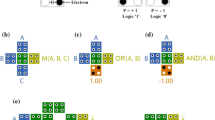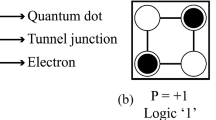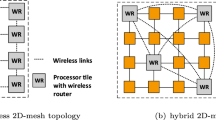Abstract
Offline and online built-in self-test (BIST) designs are low-cost platforms to test very complex modern chips. The offline BIST design embeds the test pattern generator (TPG) into the chip to be activated in the test time. On the other hand, the online (or concurrent) BIST design eliminates the TPG and utilizes the system’s input vectors to accomplish the test process. This paper proposes a BIST design that supports both online and offline tests. In the online part of the design, a selector module passes the input vectors which belong to a pre-computed test set to the reduction part. The test set contains the test vectors, which generate 0 remainders in the division by the LFSR’s polynomial of the selector. In the concurrent test latency (CTL) aware design, the size of the test set is expanded by adopting the selecting part to select the test vectors which generate the same remainders in the division by two different polynomials. The internal TPG of the offline part is realized based on the HW-aware test set using the shifted versions of LFSR’s polynomial and XORing their contents. The reduction part compresses the widths of the current test vector and the related CUT outputs. The compactor LFSR compresses the test vectors so that the resulted remainders would be different for all test vectors to solve the masking problem. The small size of the test set and the compacting test vectors resulted in a tremendous reduction of hardware overhead. The proposed method imposes less than 6% and 28% hardware overhead for large size and very large size circuits, respectively. The simulation results for ISCAS 85, ISCAS 89, and ITC99 benchmark circuits showed that our proposed BIST design outperforms the previous state-of-the-art in both hardware overheads. Furthermore, the CTL reduces 100 times by the proposed CTL-aware approach on average.











Similar content being viewed by others
Data Availability
The datasets generated and/or analyzed during the present study are available from the corresponding author on reasonable request.
References
Abramovici M, Breuer M, Friedman A (1990) Digital Systems Testing and Testable Design. Computer Science Press
Acevedo O, Kagaris D (2015) On the computation of LFSR characteristic polynomials for built-in deterministic test pattern generation. IEEE Trans Comput 65(2):664–669
Askarzadeh M, Haghparast M, Jabbehdari S (2021) "Power consumption reduction in built-in self-test circuits." J Ambient Intell Humaniz Comput 1–14
Biswas S, Das SR, Petriu EM (2006) Space compactor design in VLSI circuits based on graph theoretic concepts. IEEE Trans Instrum Meas 55(4):1106–1118
Divyapreethi B, Karthik T (2015) “Input Vector Monitoring Concurrent BIST Architecture using Modified SRAM Cells", ARPN. J Eng Appl Sci 10(9):4042–4046
Efanov DV, Sapozhnikov VV, Sapozhnikov VV (2017) "Conditions for detecting a logical element fault in a combination device under concurrent checking based on Berger’s code." Autom Remote Control 78(5):891–901
Emara AS, Romanov D, Roberts GW, Aouini S, Ziabakhsh S, Parvizi M, Ben-Hamida N (2021) "An Area-Efficient High-Resolution Segmented Σ Δ-DAC for Built-In Self-Test Applications." IEEE Trans Very Large Scale Integr VLSI Syst 29(11):1861-1874
Floridia A, Mongano G, Piumatti D, Sanchez E (2019) "Hybrid online self-test architecture for computational units on embedded processor cores." In 2019 IEEE 22nd International Symposium on Design and Diagnostics of Electronic Circuits & Systems (DDECS) 1–6. IEEE.
Jahanirad H (2019) Efficient reliability evaluation of combinational and sequential logic circuits. J Comput Electron 18(1):343–355
Jahanirad H, Karam H (2017) BIST-based Testing and Diagnosis of LUTs in SRAM-based FPGAs. Emerging Science Journal 1(4):216–225
Jahanirad H, Karam H (2018) "BIST-Based Online Test Approach for SRAM-Based FPGAs." In Proc. Iranian Conf. Electrical Engineering (ICEE), pp. 178–183
Jurj SL, Rotar R, Opritoiu F, Vladutiu M (2020) "Online Built-In Self-Test Architecture for Automated Testing of a Solar Tracking Equipment." In Proc. IEEE International Conference on Environment and Electrical Engineering and IEEE Industrial and Commercial Power Systems Europe (EEEIC/I&CPS Europe), pp. 1–7
Kochte MA, Zoellin CG, Wunderlich H-J (2010) Efficient Concurrent Self-Test with Partially Specified Patterns. Journal of Electric Testing 26(5):581–594
Martínez LH, Khursheed SS, Reddy SM (2020) "LFSR generation for high test coverage and low hardware overhead." IET Computers & Digital Techniques 14(1):27–36
Murugan SV, Sathiyabhama B (2021) "Bit-swapping linear feedback shift register (LFSR) for power reduction using pre-charged XOR with multiplexer technique is built-in self-test." J Ambient Intell Humaniz Comput 12(6): 6367–6373
Nikitha SA, Paulin S, Venkateshwaran SP (2015) "A concurrent BIST architecture for online input vector monitoring." In Proc. International Conference on Science, Technology, and Management, pp. 1411–1488
Pavlidis A, Louërat, MM, Faehn E, Kumar A, Stratigopoulos HG (2020) "Symmetry-based A/MS BIST (SymBIST): Demonstration on a SAR ADC IP" In Proc. Design, Automation and Test in Europe Conference and Exhibition (DATE), pp. 282–285
Pavlidis A, Louërat MM, Faehn E, Kumar A, Stratigopoulos HG (2021) "SymBIST: Symmetry-Based Analog and Mixed-Signal Built-In Self-Test for Functional Safety." IEEE Trans Circuits Syst I Regul Pap 68(6):2580–2593
Roth J (1966) Paul, “Diagnosis of automata failures: A calculus and a method.” IBM J Res Dev 10(4):278–291
Saluja KK, Sharma R, Kime CR (1987) "Concurrent comparative testing using BIST resources." In Proc. International Conference on Comput Aided Des, pp. 336–339
Saluja KK, Sharma R, Kime CR (1987) Concurrent comparative built-in testing of digital circuits. University of Wisconsin, Engineering Experiment Station
Saluja KK, Sharma R, Kime CR (1988) “A concurrent testing technique for digital circuits”, IEEE Trans. Comput Aided Design Integr Circuits Syst 7(12):1250–1260
Sharma R, Saluja KK (1993) Theory, analysis, and implementation of an online BIST technique. VLSI Design 1(1):9–22
Shivakumar V, Senthilpari C, Yusoff Z (2021) A Low-Power and Area-Efficient Design of a Weighted Pseudorandom Test-Pattern Generator for a Test-Per-Scan Built-in Self-Test Architecture. IEEE Access 9:29366–29379
Voyiatzis I (2012) "Input Vector Monitoring Online Concurrent BIST based on multi-level decoding logic." In Proc. Design, Automation & Test in Europe Conference & Exhibition (DATE), pp. 1251–1256
Voyiatzis I, Efstathiou C (2013) Input vector monitoring concurrent BIST architecture using SRAM cells. IEEE Transactions on Very Large Scale Integration (VLSI) Systems 22(7):1625-1629
Voyiatzis I, Halatsis C (2005) "A Low-Cost Concurrent BIST Scheme for Increased Dependability," IEEE Trans Dependable Secure Comput 2(2):150-156
Voyiatzis I, Paschalis A, Gizopoulos D, Halatsis C, Makri FS, Hatzimihail M (2008) An input vector monitoring concurrent BIST architecture based on a pre-computed test set. IEEE Trans Comput 57(8):1012–1022
Voyiatzis I, Paschalis A, Gizopoulos D, Kranitis N, Halatsis C (2005) A Concurrent Built-In Self Test Architecture Based on a Self-Testing RAM. IEEE Trans Reliability 54(1):69–78
Wang R, Chakrabarty K, Bhawmik S (2015) Built-in self-test and test scheduling for interposer-based 2.5 D IC. ACM Transactions on Design Automation of Electronic Systems (TODAES) 20(4):1–24
Wang C-H, Hsieh T-Y (2017) On the probability of detection lossless concurrent error detection based on implications. IEEE Trans Comput Aided Des Integr Circuits Syst 37(5):1090–1103
Wu TB, Liu HZ, Liu P.X, Guo DS, Sun HM (2013) A cost-efficient input vector monitoring concurrent online BIST scheme based on multi-level decoding logic. J Electron Test 29(4):585–600
Funding
There is no funding related to this study.
Author information
Authors and Affiliations
Corresponding author
Ethics declarations
Conflict of Interest
The authors declare that they have no known competing financial interests or personal relationships that could have appeared to influence the work reported in this paper.
Additional information
Responsible Editor: K. K. Saluja
Publisher's Note
Springer Nature remains neutral with regard to jurisdictional claims in published maps and institutional affiliations.
Rights and permissions
About this article
Cite this article
Menbari, A., Jahanirad, H. A Low-cost BIST Design Supporting Offline and Online Tests. J Electron Test 38, 107–123 (2022). https://doi.org/10.1007/s10836-022-05986-0
Received:
Accepted:
Published:
Issue Date:
DOI: https://doi.org/10.1007/s10836-022-05986-0




